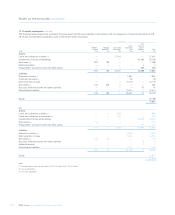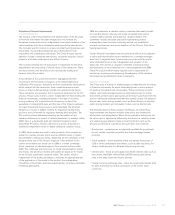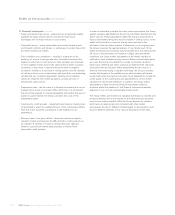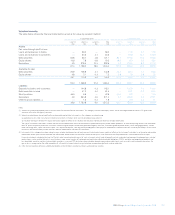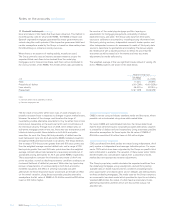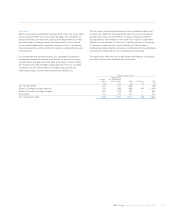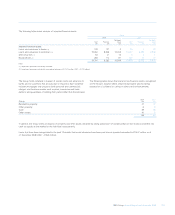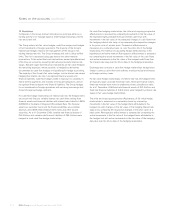RBS 2008 Annual Report Download - page 206
Download and view the complete annual report
Please find page 206 of the 2008 RBS annual report below. You can navigate through the pages in the report by either clicking on the pages listed below, or by using the keyword search tool below to find specific information within the annual report.
205RBS Group Annual Report and Accounts 2008
Due to the subjectivity of the inputs to the pricing model, alternative
valuation points are constructed to benchmark the output of the model.
These valuation points include determining an ABS index implied
collateral valuation, which provides a market calibrated valuation data
point. A collateral net asset value methodology is also considered which
uses dealer buy side marks to determine an upper bound for super
senior CDO valuations. Both the ABS index implied valuation and the
collateral net asset value methodology apply an assumed immediate
liquidation approach.
The Group, using all pricing points available, may make necessary and
appropriate valuation adjustments to the pricing information derived
from the proprietary model. These adjustments reflect the Group’s
assessment of factors that market participants would consider in setting
a price, to the extent that these factors that have not already been included
in the model and may include adjustments made for liquidity discounts.
In order to provide disclosures of the valuation of super senior CDOs
using reasonably possible alternative assumptions, the Group has
considered macroeconomic conditions, including house price
appreciation and depreciation, and the effect of regional variations. The
output from using these alternative assumptions has been compared
with inferred pricing from other published data. The Group believes that
reasonably possible alternative assumptions could reduce or increase
valuations by up to 4%. Using these alternative assumptions would
reduce the fair value of level 3 CDOs of £1.7 billion by up to £440 million
(super senior CDOs: £292 million) and increase the fair value by up to
£410 million (super senior CDOs: £292 million).
Collateralised loan obligations
To determine the fair value of CLOs purchased from third parties, the
Group use third-party broker or lead manager quotes as the primary
pricing source. These quotes are benchmarked to consensus pricing
sources where they are available.
For CLOs originated and still held by the Group, the fair value is
determined using a correlation model based on a Monte Carlo
simulation framework. The main model inputs are credit spreads and
recovery rates of the underlying assets and their correlation. A credit
curve is assigned to each underlying asset based on prices, from third-
party dealer quotes, and cash flow profiles, sourced from an industry
standard model. Losses are calculated taking into account the
attachment and detachment point of the exposure. As the correlation
inputs to this model are not observable CLOs are deemed to be level 3.
Using reasonably possible alternative assumptions the fair value of
CLOs of £1.0 billion would be £40 million lower or £40 million higher.
Other debt securities
Other level 3 debt securities comprise £1.4 billion of other ABS and
£1.7 billion of other debt securities. Where observable market prices for
a particular debt security are not available, the fair value will typically be
determined with reference to observable market transactions in other
related products, such as similar debt securities or credit derivatives.
Assumptions are made about the relationship between the individual
debt security and the available benchmark data. Where significant
management judgement has been applied in identifying the most relevant
related product, or in determining the relationship between the related
product and the instrument itself, the valuation is shown in level 3. Using
differing assumptions about this relationship would result in different fair
values for these assets. The main assumption made is that of relative
creditworthiness. Using reasonably possible alternative assumption
credit assumptions, taking into account the underlying currency, tenor,
and rating of the debt securities within each portfolio, would reduce the
fair value of other debt securities of £3.1 billion by up to £50 million or
increase the fair value by up to £50 million.
Derivatives
Level 3 derivative assets comprised credit derivatives of £8.0 billion, equity
derivatives of £0.1 billion and interest rate, foreign exchange rate and
commodity derivative contracts of £2.2 billion. Derivative liabilities
comprise credit derivatives of £2.6 billion interest rate, foreign exchange
rate and commodity derivatives contracts of £1.4 billion.
Derivatives are priced using quoted prices for the same or similar
instruments where these are available. However, the majority of
derivatives are valued using pricing models. Inputs for these models are
usually observed directly in the market, or derived from observed
prices. However, it is not always possible to observe or corroborate all
model inputs. Unobservable inputs used are based on estimates taking
into account a range of available information including historic analysis,
historic traded levels, market practice, comparison to other relevant
benchmark observable data and consensus pricing data.
Credit derivatives
The Group’s credit derivatives include vanilla and bespoke portfolio
tranches, gap risk products and certain other unique trades. The
bespoke portfolio tranches are synthetic tranches referenced to a
bespoke portfolio of corporate names on which the Group purchases
credit protection. Bespoke portfolio tranches are valued using Gaussian
Copula, a standard method which uses observable market inputs
(credit spreads, index tranche prices and recovery rates) to generate an
output price for the tranche via a mapping methodology. In essence this
method takes the expected loss of the tranche expressed as a fraction
of the expected loss of the whole underlying portfolio and calculates
which detachment point on the liquid index, and hence which
correlation level, coincides with this expected loss fraction. Where the
inputs into this valuation technique are observable in the market,
bespoke tranches are considered to be level 2 assets. Where inputs are
not observable, bespoke tranches are considered to be level 3 assets.
However, all transactions executed with a CDPC counterparty are
considered level 3 as the counterparty credit risk assessment is a
significant component of these valuations.
Gap risk products are leveraged trades, with the counterparty’s
potential loss capped at the amount of the initial principal invested. Gap
risk is the probability that the market will move discontinuously too quickly
to exit a portfolio and return the principal to the counterparty without
incurring losses, should an unwind event be triggered. This optionality is
embedded within these portfolio structures and is very rarely traded
outright in the market. Gap risk is not observable in the markets and, as
such, these structures are deemed to be level 3 instruments.
Other unique trades are valued using a specialised model for each
instrument and the same market data inputs as all other trades where
applicable. By their nature, the valuation is also driven by a variety of
other model inputs, many of which are unobservable in the market.





